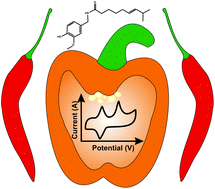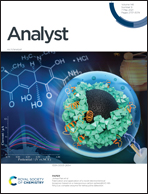Electroanalytical overview: the pungency of chile and chilli products determined via the sensing of capsaicinoids
Abstract
When you bite into a chile pepper or eat food containing chile (chilli), one might feel heat, or other associated feelings, some good such as the release of endorphins, and some bad. The heat, or pungency, and related feelings from eating chile peppers are the result of their chemical composition, i.e. the concentrations of capsaicinoids. The major components are capsaicin and dihydrocapsaicin, which occur in chiles in the ratio of 6 : 4. Other capsaicinoids occur in smaller concentrations and are known as the “minor” capsaicinoids. Wilbur L. Scoville in 1912 created an organoleptic test, now known as the Scoville scale, which asked a panel of tasters to state when an increasingly dilute solution of the chile pepper in alcohol no longer burned the mouth. Following the Scoville scale, a plethora of analytical techniques later followed. In this overview, we explore the endeavours directed to the development of electrochemical-based sensors for the determination of capsaicin and related compounds, starting from their use in hyphenated laboratory set-ups to their modern use as stand-alone electroanalytical sensors. The latter have the advantage of providing a rapid and sensitive methodology that has the potential to be translated in the field; future trends and issues to be overcome are consequently suggested.

- This article is part of the themed collection: Recent Review Articles


 Please wait while we load your content...
Please wait while we load your content...